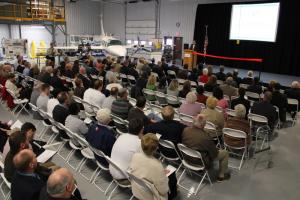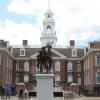Del Tech facility named to honor Lewes astronaut
Joe Hudson says he always knew Ted Freeman would fly airplanes.
The two became best friends in elementary school and soon after were flying on their own.
“We learned to fly together as kids at age 15,” Hudson said. “I knew he would go on to bigger things, and he did.”
Freeman moved on to the U.S. Naval Academy after graduating from Lewes High School. He later joined the U.S. Air Force as a pilot before entering the highly selective aerospace school at Edwards Air Force Base becoming one of 14 astronauts chosen to fly to the moon. Tragically, Freeman never made it to space. His plane crashed in 1964 near Houston during a routine flight.
In honor of Freeman's hard work, perserverance and legacy, Delaware Technical Community College on Feb. 18 named its new aviation maintenance building after him.
“Today we open a new building and program in honor of a world-class human being,” said Ileana M. Smith, vice president and campus director of the Owens Campus.
The 9,800-square-foot building will allow students to learn airplane engine maintenance giving them more opportunities to find employment in the aviation field, said Del Tech President Orlando George.
“Programs like this are investments … investments in people, in Sussex Countians, in Delawareans and in our business community,” he said.
Airplane maintenance is a major growth industry as more and more mechanics retire from the workforce, said Del Tech instructor Tim DiVietro. Based on industry reports, he said, 80 percent of the current aviation workforce is 40 years old or older.
DiVietro notes a long-term employment outlook for the industry indicates over the next few years there will be an annual average of 10,000 job openings for aircraft avionics maintenance personnel, increasing to 40,000 openings per year. These numbers are the result of analysis of anticipated aviation industry growth rates and projected retirements of the World War II and Korea era veterans, who presently hold many of the aviation maintenance jobs in airline and general aviation activities, according to the study.
The pay isn't bad, either.
DiVietro said regional helicopter producer Sikorski recently listed jobs starting at $35 an hour with as little as three years of experience.
“There's a growing demand for aviation mechanics,” said Barry Weiss, aviation maintenance department chair.
Aviation giant Boeing has said it will need hundreds of thousands of mechanics to replace baby boomers retiring in the near future, he said. Locally, PATS Aircraft is looking to grow with an expanded runway to accommodate 737 airliners in need of maintenance. Both government and school officials are lobbying for another 500-foot expansion that would open the airport to larger jets in need of service.
Evan Clark is enrolled in Del Tech's power plant program. Two years ago, he was hired full-time as a mechanical systems technician by PATS. Del Tech's airframe course gave him the skills needed to maintain the outside of a plane, he said. A power plant certificate will teach him how to maintain the engine and other inside parts. Combined, he said, the two courses will make him marketable.
“It will allow me to sign off on engine work and travel,” he said.
Already, Clark said, he was asked to go to Kuwait for airplane maintenance, but he had to decline because he did not have the engine experience. Once he completes the eight-month course, however, he anticipates plenty of job opportunities.
Clark is part of a group of 24 students who will learn to maintain, repair, assemble and take apart airplane engines. The six-bay work area has a couple of permanent aircraft inside including a five-seater Lear jet. Smaller planes can be taxied in and out of a giant garage door.
Weiss said students are required to complete 79 projects including work on smaller engines similar to an automobile engine design and bigger turbo-powered systems used by jets.
“They'll get a lot of hands-on experience,” he said.
Money for the $1.4 million building was raised through a combination of state, federal and private funds. It's a partnership that will benefit the state in the long run, said Gov. Jack Markell.
“Let's recognize that by investing in human capital and infrastructure… we'll see more jobs,” he said.
Markell joined dignitaries from across Sussex County and the state in dedicating the building. Helping celebrate was Freeman's only daughter, Faith, and other friends and members of the Freeman family.
Faith, a native Texan, was only 10 when her father died. He is remembered as a hero who bravely guided his crashing jet away from a populated neighborhood after the jet's engines failed.
A mural covering the hallway entrance of the new building, pays homage to Freeman and his lifetime of accomplishments.
Snapshots of Freeman's life illustrate a timeline, from his early days flying over the Cape Region as a teenager to his training for the Apollo mission alongside astronauts Gordon Cooper, Buzz Aldrin, Gene Cernan and Alan Bean. All 28 astronauts attended Freeman's funeral at Arlington Cemetary in 1964.
The mural describes Freeman as an outstanding pilot, highly regarded by NASA, who would have flown to and walked on the moon if not for the crash.
“The ceremony was so touching because it reminds me of my father and his gifts,” Faith Freeman Johnson said.































































